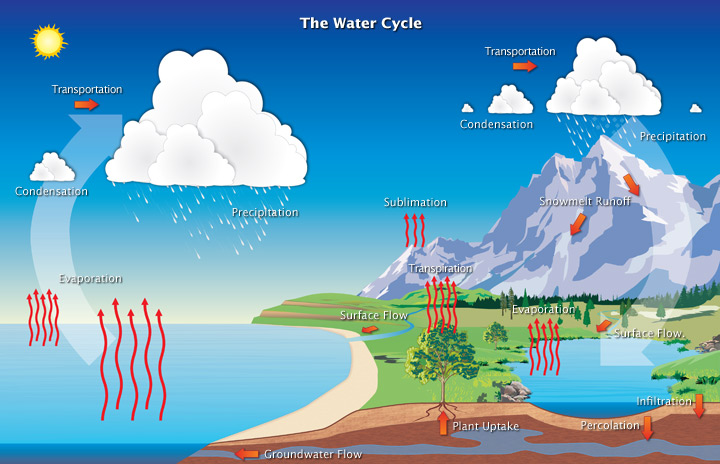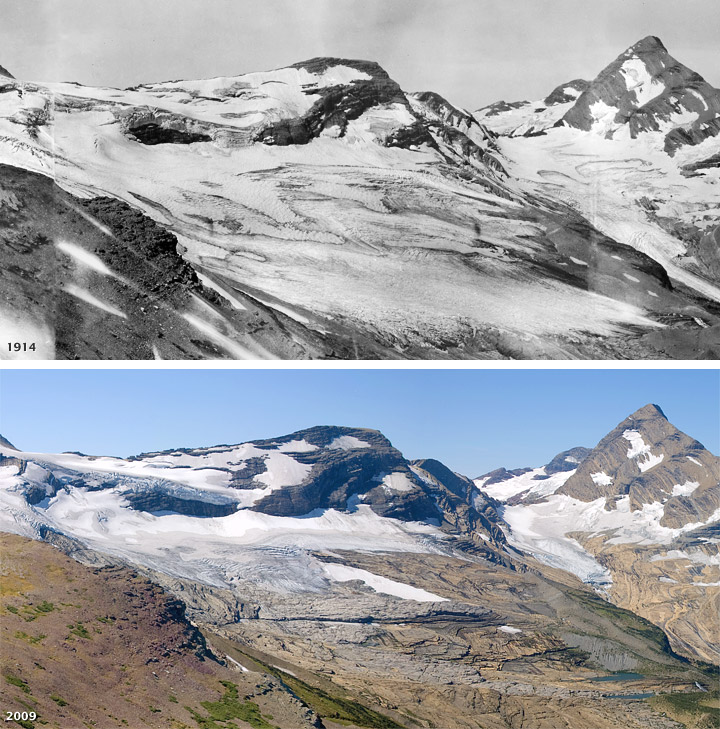What Happens to Water Once It Reaches Earths Surface
A Multi-Phased Journeying
The water, or hydrologic, cycle describes the pilgrimage of h2o every bit water molecules make their way from the Earth's surface to the atmosphere and back again, in some cases to below the surface. This gigantic organisation, powered past free energy from the Sunday, is a continuous commutation of moisture betwixt the oceans, the atmosphere, and the state.

World's water continuously moves through the temper, into and out of the oceans, over the land surface, and underground. (Image courtesy NOAA National Weather Service Jetstream.)
Studies have revealed that evaporation—the process by which h2o changes from a liquid to a gas—from oceans, seas, and other bodies of water (lakes, rivers, streams) provides near 90% of the moisture in our atmosphere. Most of the remaining 10% found in the temper is released by plants through transpiration. Plants take in water through their roots, then release it through small-scale pores on the underside of their leaves. In addition, a very pocket-size portion of water vapor enters the atmosphere through sublimation, the procedure by which water changes directly from a solid (water ice or snowfall) to a gas. The gradual shrinking of snow banks in cases when the temperature remains below freezing results from sublimation.
Together, evaporation, transpiration, and sublimation, plus volcanic emissions, account for almost all the water vapor in the atmosphere that isn't inserted through human activities. While evaporation from the oceans is the primary vehicle for driving the surface-to-atmosphere portion of the hydrologic bike, transpiration is also significant. For example, a cornfield i acre in size can transpire equally much as iv,000 gallons of h2o every day.
Subsequently the water enters the lower atmosphere, rising air currents deport it upward, often loftier into the atmosphere, where the air is cooler. In the absurd air, water vapor is more likely to condense from a gas to a liquid to grade cloud droplets. Cloud droplets can grow and produce precipitation (including rain, snow, sleet, freezing pelting, and hail), which is the primary mechanism for transporting water from the atmosphere back to the Earth'due south surface.
When precipitation falls over the land surface, it follows diverse routes in its subsequent paths. Some of it evaporates, returning to the atmosphere; some seeps into the ground as soil wet or groundwater; and some runs off into rivers and streams. Almost all of the water eventually flows into the oceans or other bodies of h2o, where the cycle continues. At dissimilar stages of the cycle, some of the water is intercepted by humans or other life forms for drinking, washing, irrigating, and a large variety of other uses.
Groundwater is plant in 2 broadly defined layers of the soil, the "zone of aeration," where gaps in the soil are filled with both air and water, and, farther downwardly, the "zone of saturation," where the gaps are completely filled with water. The boundary between these two zones is known as the water table, which rises or falls as the corporeality of groundwater changes.
The corporeality of h2o in the atmosphere at any moment in time is simply 12,900 cubic kilometers, a minute fraction of World's full h2o supply: if information technology were to completely pelting out, atmospheric moisture would cover the Globe'south surface to a depth of just 2.five centimeters. However, far more water—in fact, some 495,000 cubic kilometers of information technology—are cycled through the temper every year. It is as if the entire corporeality of h2o in the air were removed and replenished well-nigh forty times a yr.

This map shows the distribution of water vapor throughout the depth of the temper during August 2010. Even the wettest regions would grade a layer of water merely 60 millimeters deep if it were condensed at the surface. (NASA paradigm by Robert Simmon, using Arrogance & AMSU data.)
H2o continually evaporates, condenses, and precipitates, and on a global basis, evaporation approximately equals precipitation. Because of this equality, the full amount of h2o vapor in the atmosphere remains approximately the same over fourth dimension. Notwithstanding, over the continents, precipitation routinely exceeds evaporation, and conversely, over the oceans, evaporation exceeds precipitation.
In the instance of the oceans, the continual excess of evaporation versus precipitation would eventually exit the oceans empty if they were not beingness replenished by additional means. Not but are they being replenished, largely through runoff from the land areas, but over the past 100 years, they have been over-replenished: sea level around the globe has risen approximately 17 centimeters over the course of the twentieth century.

Ocean level has risen both because of warming of the oceans, causing h2o to aggrandize and increase in volume, and because more water has been inbound the ocean than the amount leaving it through evaporation or other means. A primary cause for increased mass of water entering the bounding main is the calving or melting of land ice (ice sheets and glaciers). Body of water ice is already in the ocean, then increases or decreases in the almanac corporeality of sea ice do not significantly affect ocean level.

Blackfoot (left) and Jackson (right) glaciers, both in the mountains of Glacier National Park, were joined forth their margins in 1914, but have since retreated into split alpine cirques. The melting of glacial ice is a major contributor to sea level rise. [Photographs past Eastward. B. Stebinger, Glacier National Park archives (1911), and Lisa McKeon, USGS (2009).]
Throughout the hydrologic cycle, in that location are many paths that a h2o molecule might follow. H2o at the lesser of Lake Superior may somewhen rise into the atmosphere and autumn equally rain in Massachusetts. Runoff from the Massachusetts rain may drain into the Atlantic Body of water and circulate northeastward toward Republic of iceland, destined to become part of a floe of sea water ice, or, later on evaporation to the temper and atmospheric precipitation as snow, function of a glacier.
H2o molecules can accept an immense variety of routes and branching trails that lead them again and again through the three phases of water ice, liquid water, and water vapor. For instance, the h2o molecules that one time fell 100 years ago as rain on your not bad- grandparents' farmhouse in Iowa might now be falling equally snowfall on your driveway in California.
Source: https://earthobservatory.nasa.gov/features/Water/page2.php